
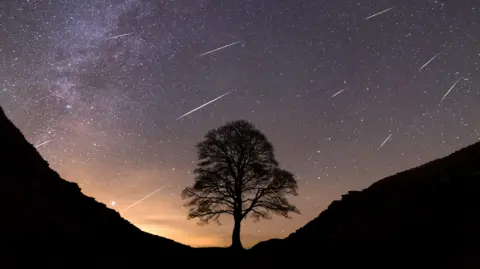 Dan Monk Kielder Observatory
Dan Monk Kielder ObservatoryRuth lost her only child Fergus to cancer when he was just 12.
“Your worst fear after your child dies is that he’ll be forgotten,” she explains.
They had long been searching for a tree with special meaning to plant in Fergus’ memory and to draw attention to all the children affected by childhood cancer.
The Sycamore Gap tree was cut down a year ago, sparking national outrage. Now, Fergus’ community in Backwell, near Bristol, will be one of the first to be gifted a sapling grown from it.
Stories of these first saplings to be promised are being shared to inspire others to apply for a ‘Tree of Hope’ from the National Trust. They have now grown to about 5ft tall, the BBC discovered on a visit to the top-secret greenhouse where they are kept.
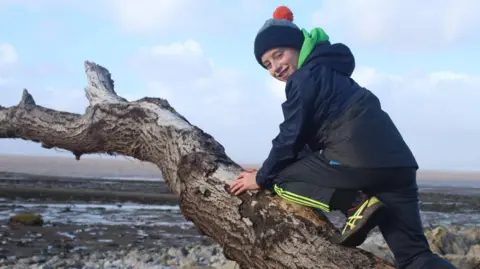 Yard family photo
Yard family photoOn a bank, overlooking an open green space, Fergus’ parents share the spot where his tree will go – a prominent place in the landscape.
Their son came to this recreational ground nearly every day – a boy, on the cusp of becoming a teenager, who had a love of the outdoors.
It was his walk to school. He played cricket and other games here with his dad Ian, who described it as place filled with “fun”.
Father and son were planning to walk Hadrian’s Wall, along which the Sycamore Gap tree was nestled.
They postponed because of the pandemic with the hope of visiting once life went back to ‘normal’.
But Fergus was diagnosed with Osteosarcoma (bone cancer) in January 2021 and was just 12 years old when he died in May 2022.
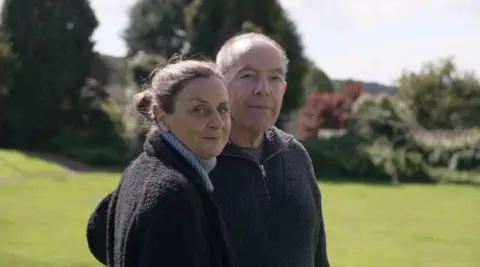 Andy Alcroft/BBC
Andy Alcroft/BBC Two years on, his mum Ruth contacted the National Trust after hearing about the seedlings and grafts successfully grown from seeds and young twigs rescued from the felled tree.
“There’s something about the story of the new life being created from the Sycamore Gap. It made me think of all the children affected by childhood cancer. And how they deserve so much better. They deserve a second chance of life.”
A Sycamore Gap sapling seemed a fitting tribute as it was the trip planned, but never taken.
Since Fergus died, nature has been a constant source of strength to the family, Ruth tells me: “Its power to regenerate. And to console.”
She stresses that cancer in children is “horrendous, brutal and life-changing” and that bone cancer in children is something “no one really talks about”.
“We need to do more. We need to know more.” So her hope for the tree is to draw attention to the challenges these children face.
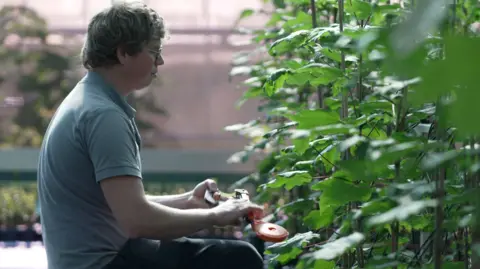 Ross James/BBC
Ross James/BBCThe original tree was 49ft (15m) when it was chopped down, and so 49 of its saplings will be released to communities across the UK who successfully apply.
The Sycamore Gap stood in a dip in Hadrian’s Wall in Northumberland, attracting visitors, proposals and was even featured in the Hollywood blockbuster Robin Hood: Prince of Thieves.
But on the morning of 28 September 2023, news spread internationally that the tree had been chopped down overnight.
Two men accused of damaging the tree and wall both deny the offence.
There was excitement over the summer when shoots started to emerge from the stump itself.
Currently its ‘baby trees’ are being nurtured and protected in a secret greenhouse, a site of biosecurity because of the rare specimens grown there – including a copy of Newton’s Apple Tree.
The first of the seedlings to pop up has been gifted to King Charles.
It was the wrong time of year to grow the material that was salvaged from the iconic tree and things have been “touch and go”, Darryl Beck, who has been tending to the seedlings explains.
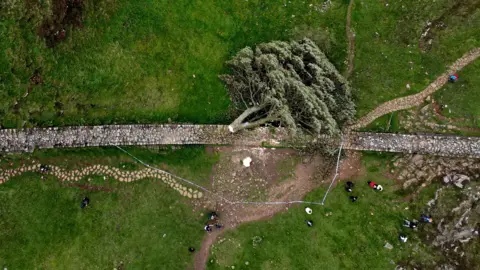 Reuters
ReutersBut now the small team here are caring for about 100 saplings, some taller than 1.5m, and more seedlings are coming on.
There are also “nine or so grafts and budded plants” Chris Trimmer who runs the site explains. They are genetic copies of the original tree.
The trees wont be ready for planting until next year.
“We’re only a very small part of the story, but these trees will be around for the next 200 to 500 years. So, they’ll be around a long time and give a lot of hope to people,” says Chris.
The National Trust wants these saplings to be symbols of hope and healing, with each tree going to a very special place.
Another is promised to Tina’s Haven at Easington on the County Durham Coast.
Some 34 hectares (84 acres) of coastal fields are set to become a landscape of rolling meadows, hedgerows, ponds and woodlands overlooking the North Sea.
“My daughter Tina was absolutely a unique human being,” Sue Robson explains. “Through her life, although she had issues with childhood trauma and addiction and mental health, she was bold, she was strong, she was beautiful.”
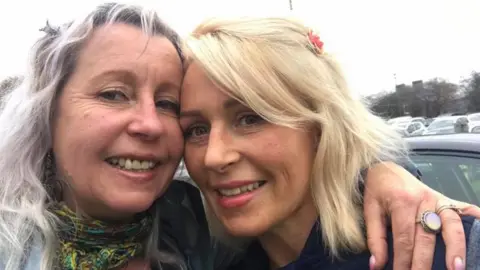 Sue Robson
Sue RobsonTina died in 2020, age 35, following these struggles. After her death, Sue wanted to create a wild sanctuary – a place of recovery for others dealing with the problems Tina faced.
The National Trust says it’s spent the last 40 years cleaning up the beaches that neighbour the former coalfield sites near where Tina’s Haven will be established.
The hope is not only to restore nature here, but to help women recover from addiction and trauma through rewilding projects.
Sue describes the pilgrimages she made to the Sycamore Gap, just 58 miles away, and how seeing it chopped down felt like an act of “violence against mother nature itself”.
“When Tina died, my hope died with her,” Sue says. “And equally, when that beautiful tree was cut down. It was a violent, devastating act.”
But she sees a “parallel” when it comes to themes of “hope, of nature, of recovery and connection.”
“So, having the tree, such a significant symbol of hope here, is absolutely massive.”
For Sue, the story of nature bouncing back, symbolises that even after being subject to the worst adversity, there can be recovery, healing and new beginnings.
“And hope can grow in abundance.”
Additional Reporting by Kristian Johnson






